Christmas toys of the past unwrapped in Leeds museum collection
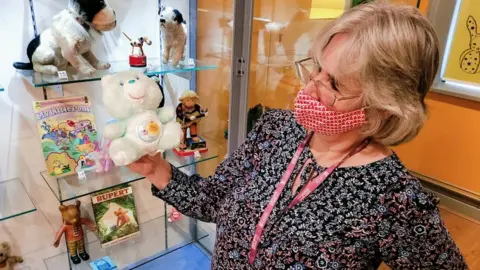 BBC
BBCIf you've spent this Christmas locked in a fruitless search for an elusive games console or twiddling your thumbs in a mile-long click and collect queue, you could be forgiven for yearning for simpler times. A new exhibition harking back to the bygone days of clockwork and metal toys could be just the tonic. But you might be surprised to find how, at their heart, the Christmas wishes of the nation's kids haven't actually changed as much as you'd think.
Curators have squeezed 100 years of kiddie fun into the glass cases at Leeds' Abbey House Museum.
Charting the evolution of the nation's must-have toys, from clockwork and metal's 1930s heyday to the post-war shift to plastic creations, its latest collection will be a nostalgia trip for many.
Kitty Ross, Leeds Museums and Galleries' curator of social history, says the aim was to reignite memories of people's childhood favourites.
Some of the oldest toys in the collection include model aeroplanes and boats, Hornby railway locomotives and a clockwork toy rollercoaster.

Among them is the tinplate toy racing car Bluebird which was based on the car used by Malcom Campbell to set a land speed record in 1927.
"This would have been a very high-end toy at the time," Ms Ross says.
"You can clearly see the theme of speed and thrill to keep kids entertained."
But four-wheeled fun and velocity wasn't always the order of the day - World War One table football game Finga-Foota makes and appearance, as well as a slightly terrifying rocking snail owned by a little girl from Kippax.

By the 1950s and 60s, the spread of popular culture such as comics and television had an influence on children's Christmas lists.
Dan Dare, pilot of the future, was the British comic hero of the era. Although not a superhero, he sometimes pulled off exceptional piloting, excelled at jiu-jitsu and was bound by a sense of honour.
No webslinger could threaten his place in the hearts of a generation of young British boys and the Dan Dare radio station playset allowed youngsters to become their science fiction hero.
"There's a tendency to think that the commercialising of toys from popular culture is a more recent thing but objects in the collection show how it's been going on a long time," says Ms Ross.
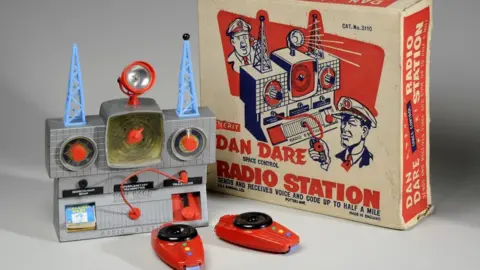 Leeds Museums and Galleries/photographed by Nor
Leeds Museums and Galleries/photographed by NorThe growing interest in fashion had an influence on toys aimed at girls, and Sindy, launched by Pedigree Toys in 1963, aimed to capitalise on this.
In her heyday, Sindy achieved a UK market share of more than 80%. She even had puffballs and evening dresses created by the Emanuels, the husband and wife team who designed Princess Diana's wedding dress.
But her popularity began to decline in the 1980s with the high-gloss glamour of racy American rival Barbie beginning to make the British girl next door look a bit old-fashioned.
Sindy may have had her three-storey townhouse and a cooker that made the sound of sizzling bacon. But Barbie could do anything - she drove a car, turned her hand to firefighting and at one point had a job as an astronaut.
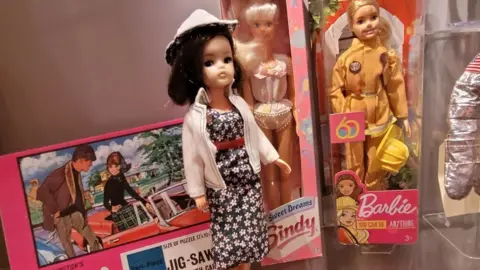
One character featured in the exhibition whose popularity spanned generations was the master of slapstick charm, Sooty, and his squeaky sidekick Sweep.
It was on a 1948 summer holiday in Blackpool when Harry Corbett bought the yellow bear glove puppet for 7s, 6d (about £11.50) as a present for his son Matthew.
Former Leeds City Council worker Corbett and his puppets starred in what would become TV's longest-running children's programme.
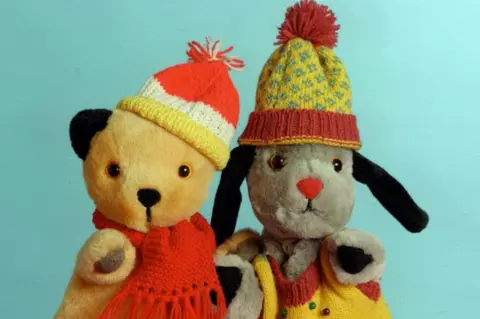 PA
PASooty, armed with a water pistol that regularly wreaked damp havoc, delighted generations of children on both the BBC and ITV. Matthew kept the madcap antics alive after his father's retirement, ensuring Sooty and Friends would find popularity for years.
For children of the 80s, the exhibition also features appearances from ubiquitous stars of many Christmas mornings - the Care Bears, the Shoe People, the "truly outrageous" rock star Jem, and toys produced on the back of the 1984 Ghostbusters film, which became a cultural phenomenon.
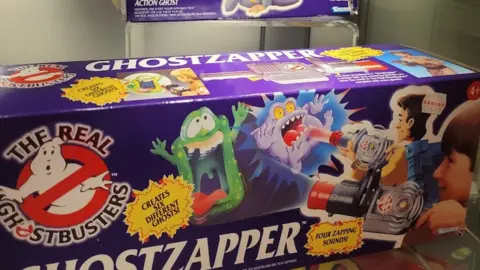
Perhaps one of the more unusual entries in the exhibition is Tufty Fluffytail - a character created to educate children about road safety but whose popularity grew to rival that of some TV and film tie-in favourites.
The young squirrel was a character used by the Royal Society for the Prevention of Accidents (RoSPA) to persuade youngsters, through simple films and stories, that the road could be a dangerous place.
Each of Tufty's adventures with his friends was plagued by the threat of potential disaster - usually involving the antics of naughty Willy Weasel.
It was a roaring success. The Tufty Club - a network of local groups - had nearly 25,000 UK branches at its peak - with millions of children proudly displaying their membership badges.
A range of story books, comics, board games, jigsaw puzzles and soft toys were among items that capitalised on Tufty's profile.
To this day, RoSPA is still very proud of its big-tailed mascot and continue to use him in its educational resources.
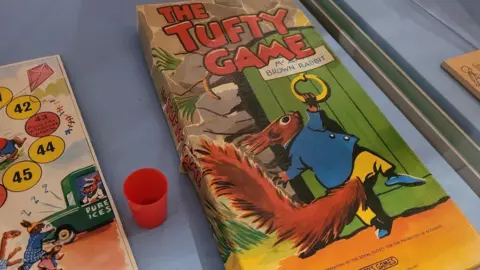
Curator Ms Ross says the collection demonstrates the "rapid and impressive evolution" toys have gone through over the past century, "powered by leaps in technology and production methods".
While the materials have advanced and beloved characters have come and gone, Ms Ross says one thing has endured.
"What has stayed consistent throughout that time though, is the unique ability which toys have to excite, inspire and capture the imaginations of children," she says.

Follow BBC Yorkshire on Facebook, Twitter and Instagram. Send your story ideas to [email protected]
